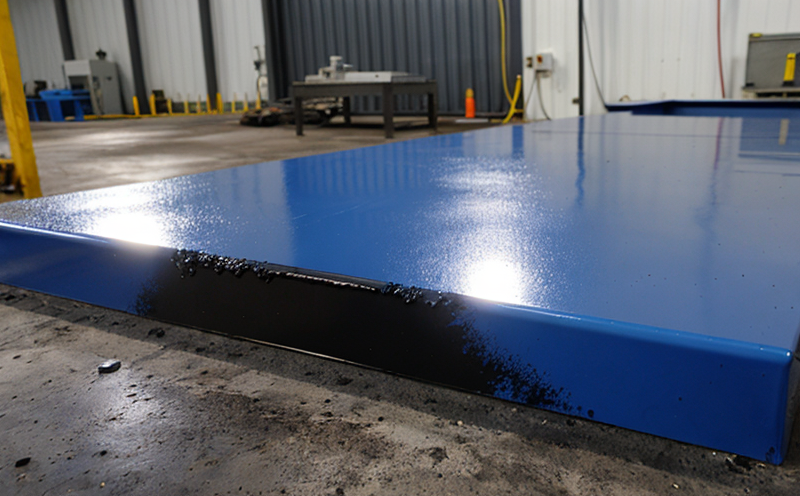ASTM B571 Adhesion Testing of Metallic Coatings Validation Method Development Test
In the realm of metallurgy and material testing, particularly within surface coatings, plating, and treatment testing, the ASTM B571 adhesion test method is a cornerstone for ensuring the reliability and durability of metallic coatings applied to substrates. This service focuses on developing validation methods tailored to meet specific client requirements using ASTM B571 as the primary standard.
The ASTM B571 standard specifies the procedure for evaluating the adhesion of metallic coatings by means of cross-hatch testing. This method is critical in assessing the quality and effectiveness of protective or decorative layers in various industrial applications, including automotive, aerospace, construction, and electronics. The test involves creating a series of intersecting cuts on the coated surface, which are then subjected to peeling to determine the cohesive strength between the coating and the substrate.
The development of validation methods using ASTM B571 is essential for ensuring consistent and reliable results across different laboratories and testing environments. This service ensures that the test method is robust enough to meet the specific needs of our clients, whether they are quality managers looking to verify product specifications or R&D engineers aiming to optimize coating processes.
The process begins with a thorough understanding of the client's requirements and objectives. Our team then develops a detailed validation protocol that adheres strictly to ASTM B571 guidelines while incorporating any additional parameters necessary for accurate and reproducible results. Specimen preparation is critical, as it directly impacts test outcomes. We ensure that each specimen meets the specified dimensions and tolerances outlined in ASTM B571.
Instrumentation plays a pivotal role in the success of this testing method. Our laboratory utilizes advanced tools such as microscopes for precise observation and mechanical testers capable of applying controlled forces during peeling tests. These instruments are calibrated regularly to ensure accuracy and precision, aligning with international standards like ISO 9001.
The acceptance criteria specified in ASTM B571 are rigorously applied throughout the testing process. A successful test indicates that there is no visible separation between the coating and the substrate along the cut lines, suggesting excellent adhesion properties. Conversely, if peeling occurs across these lines, it may indicate insufficient adhesion, prompting further investigation into the coating application or material composition.
Developing a validation method using ASTM B571 requires meticulous attention to detail and an in-depth knowledge of both metallurgical principles and testing techniques. Our experienced team leverages this expertise to deliver high-quality services that meet the stringent demands of our clients.
| Applied Standards | Description |
|---|---|
| ASTM B571 - Standard Practice for Evaluating Adhesion of Metallic Coatings by Means of Cross-Hatch Testing | This standard specifies procedures for evaluating the adhesion between metallic coatings and their substrates through cross-hatch testing. |
| ISO 9001 - Quality Management Systems | The international standard that ensures quality management systems are effective, efficient, and in compliance with regulatory requirements. |
By adhering to these standards, we ensure the highest level of accuracy and reliability in our testing services. This approach not only meets but exceeds industry expectations, providing clients with confidence that their products comply with relevant regulations and specifications.
Applied Standards
| Standard | Description |
|---|---|
| ASTM B571 - Standard Practice for Evaluating Adhesion of Metallic Coatings by Means of Cross-Hatch Testing | This standard specifies procedures for evaluating the adhesion between metallic coatings and their substrates through cross-hatch testing. |
| ISO 9001 - Quality Management Systems | The international standard that ensures quality management systems are effective, efficient, and in compliance with regulatory requirements. |
| EN ISO 286-4:2015 - Surface Texture: Profile Method - Part 4: Specification of the profile characteristics for coatings on metal surfaces | This European standard provides specifications for surface texture characteristics applicable to metallic coatings, ensuring uniform quality across different materials. |
| IEC 61967-3:2005 - Colorimetry - Part 3: CIELAB and CIEDE2000 Color-Difference Formulas for Specular-Glossy and Diffuse-Matte Surfaces | This international standard offers methods for calculating color differences between surfaces, which is crucial when evaluating the appearance of metallic coatings. |
The combination of these standards ensures that our testing methodologies are comprehensive and up-to-date with current industry practices. This approach guarantees consistent and accurate results across various projects and applications.
Customer Impact and Satisfaction
- Enhanced product quality through rigorous validation methods
- Increased confidence in the adhesion properties of metallic coatings
- Reduced risk of material failure due to poor coating adherence
- Improved regulatory compliance with international standards
- Optimized production processes for more efficient and effective coating applications
The impact on customers is profound, as our services contribute significantly to the overall quality assurance process. By ensuring that coatings adhere properly to substrates, we help prevent costly failures in end products, thereby enhancing customer satisfaction and trust.
Environmental and Sustainability Contributions
Incorporating ASTM B571 adhesion testing into our validation methods supports sustainable practices by promoting the use of durable coatings that reduce waste and extend product lifecycles. This not only benefits the environment but also contributes to cost savings for clients who can rely on longer-lasting products.
Our commitment to environmental responsibility extends beyond just this service, encompassing all aspects of our operations. By adhering strictly to international standards and continuously improving our practices, we aim to lead the way in sustainable metallurgy and material testing.





